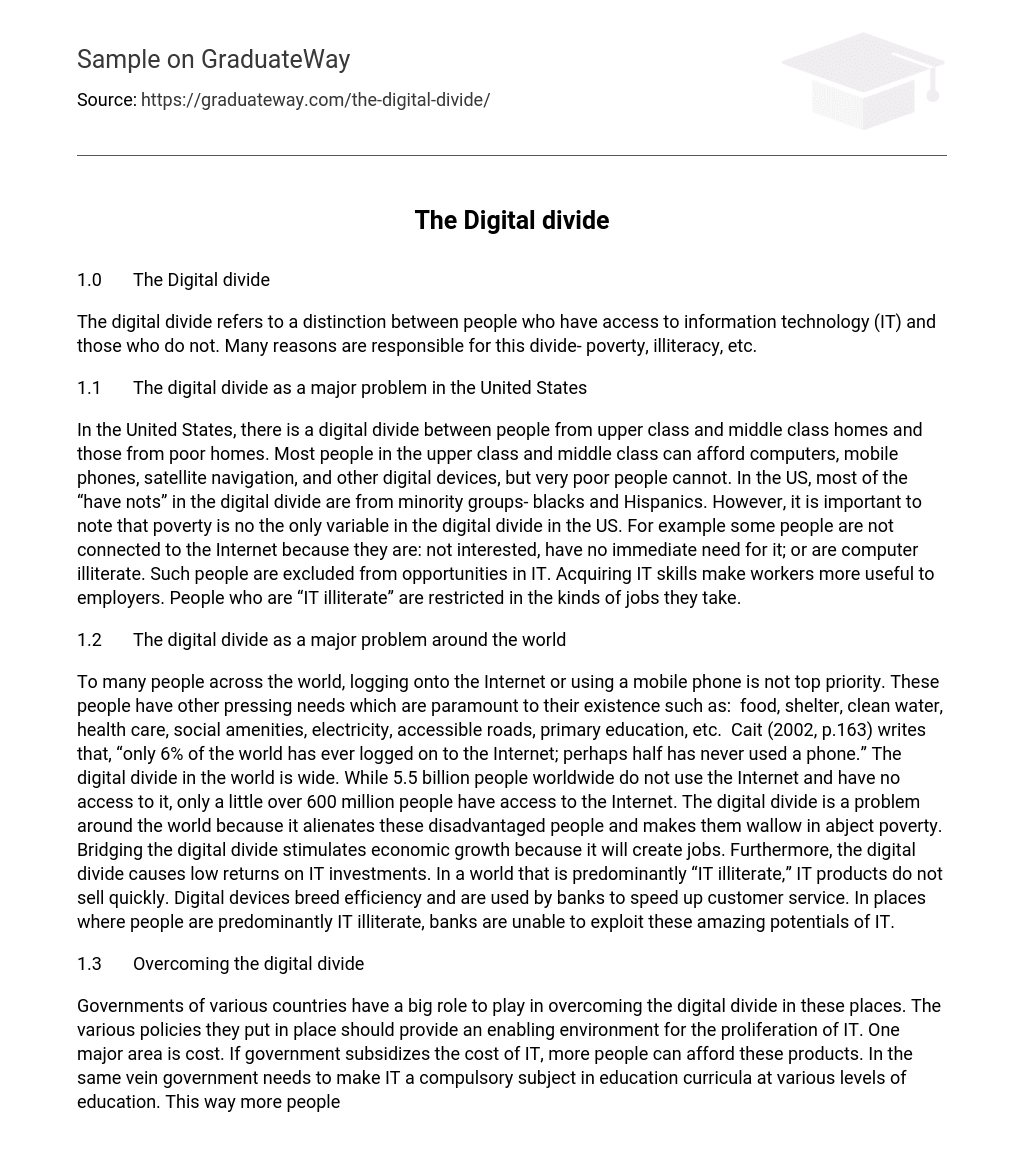1.0 The Digital divide
The digital divide refers to a distinction between people who have access to information technology (IT) and those who do not. Many reasons are responsible for this divide- poverty, illiteracy, etc.
1.1 The digital divide as a major problem in the United States
In the United States, there is a digital divide between people from upper class and middle class homes and those from poor homes. Most people in the upper class and middle class can afford computers, mobile phones, satellite navigation, and other digital devices, but very poor people cannot. In the US, most of the “have nots” in the digital divide are from minority groups- blacks and Hispanics. However, it is important to note that poverty is no the only variable in the digital divide in the US. For example some people are not connected to the Internet because they are: not interested, have no immediate need for it; or are computer illiterate. Such people are excluded from opportunities in IT. Acquiring IT skills make workers more useful to employers. People who are “IT illiterate” are restricted in the kinds of jobs they take.
1.2 The digital divide as a major problem around the world
To many people across the world, logging onto the Internet or using a mobile phone is not top priority. These people have other pressing needs which are paramount to their existence such as: food, shelter, clean water, health care, social amenities, electricity, accessible roads, primary education, etc. Cait (2002, p.163) writes that, “only 6% of the world has ever logged on to the Internet; perhaps half has never used a phone.” The digital divide in the world is wide. While 5.5 billion people worldwide do not use the Internet and have no access to it, only a little over 600 million people have access to the Internet. The digital divide is a problem around the world because it alienates these disadvantaged people and makes them wallow in abject poverty. Bridging the digital divide stimulates economic growth because it will create jobs. Furthermore, the digital divide causes low returns on IT investments. In a world that is predominantly “IT illiterate,” IT products do not sell quickly. Digital devices breed efficiency and are used by banks to speed up customer service. In places where people are predominantly IT illiterate, banks are unable to exploit these amazing potentials of IT.
1.3 Overcoming the digital divide
Governments of various countries have a big role to play in overcoming the digital divide in these places. The various policies they put in place should provide an enabling environment for the proliferation of IT. One major area is cost. If government subsidizes the cost of IT, more people can afford these products. In the same vein government needs to make IT a compulsory subject in education curricula at various levels of education. This way more people will be IT literate and able to use the technology. Government can also improve access to the internet by providing service in libraries. The mass media as well need to educate people about the benefits of IT. This will encourage them to learn. Non profit organizations who work in poor communities should create awareness and impart IT skills to people living in such places as a pathway out of poverty.
1.4 Role of IT professionals and IT companies in overcoming the digital divide
With the current rates of “IT illiteracy,” it is evident that there needs to be concerted efforts in IT teaching. IT professionals should make business people as well as ordinary citizens aware of the many benefits of IT. Also, they should provide free training in disadvantaged communities
To IT companies, the digital divide presents a business opportunity. Many of the “have nots” in the digital divide are potential market for these companies. If these companies use the appropriate marketing strategies, they will tap these markets effectively and make quick profit. An example of this is the “simputer” developed in India to encourage the use of IT. The “simputer” is a device with a touch screen that responds aloud in Indian languages. The simputer was made by four Indian scientists and made remarkable sales in India. Bridging the digital divide can be very profitable for IT companies. Also, IT companies should provide free versions of software, especially online so that people who cannot afford can have access.
References
Cait, Murphy (2002) “The Hunt for Globalization That Works” Fortune 28 October p. 163.





